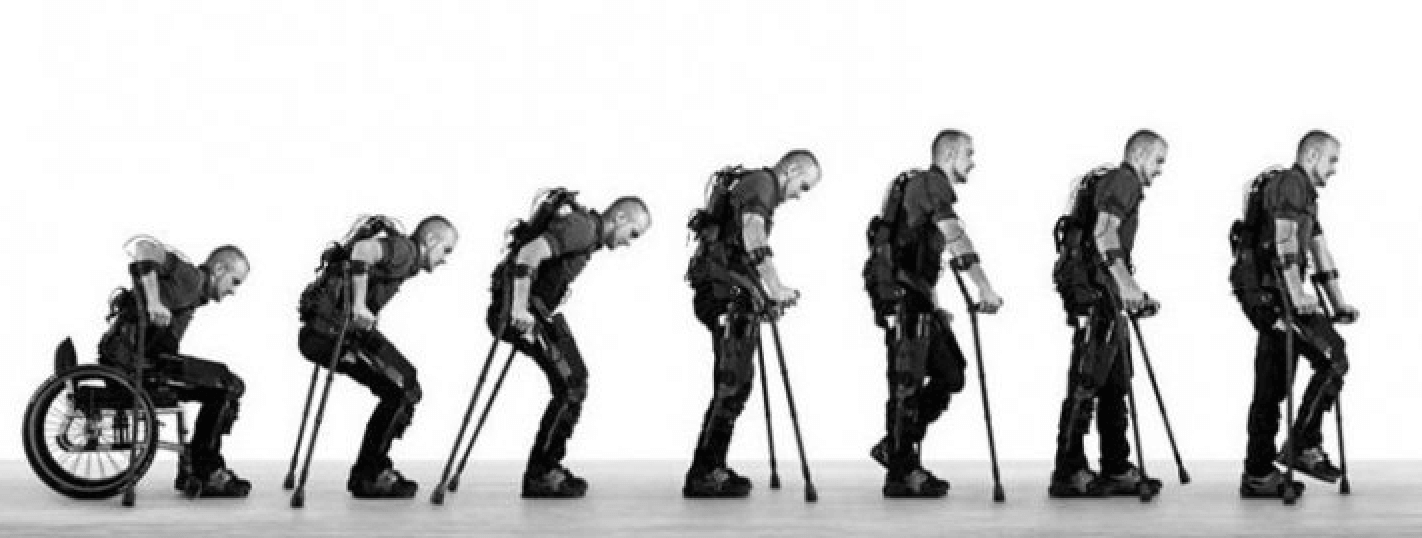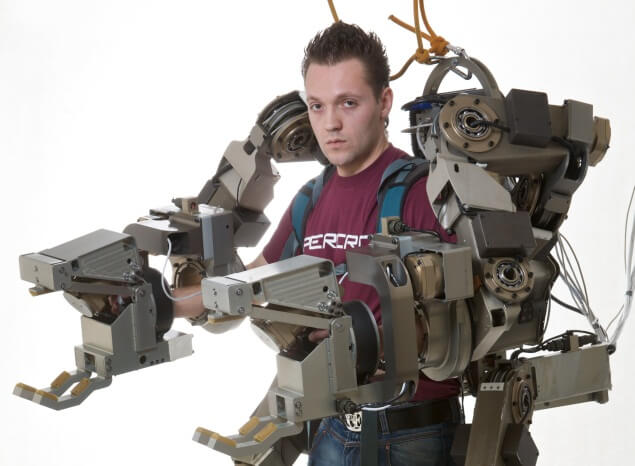Reading headlines about robot exoskeletons, or bionic suits, may evoke images of Sigourney Weaver using such a device against giant insectoid creatures in the 1980s science fiction classic Aliens. Or, you may recall a movie from last summer, Edge of Tomorrow, in which Tom Cruise donned such a suit as a futuruistic soldier.
Futuristic characters on the boundary between human and robot also have been central to the stories of RoboCop, the Terminators, Transformers and Iron Man. What all of these stories have in common is a lot of fighting, and the potential sci-fi-like military application is not crazy.
Today, both robot and exoskeleton technology have been advancing, largely through research supported by the Defense Advanced Research Projects Agency (DARPA). But when it comes to putting the technology to immediate, practical use, the battlefield is not the first setting where it will happen. Rather, the opposite is true; robotic technology, exoskeleton technology in particular is being applied medically, to give mobility to victims nervous system trauma.
Competing visions of our cyborg future
The word “cyborg” has come to mean an individual who is human, but with robotic or bionic replacement parts that have been integrated surgically with the rest of the body. A well-known extreme sci-fi example is the race called “the Borg“, on Star Trek. On Star Trek, people absorbed by the Borg became cyborgs by virtue of receiving numerous bionic implants. But they also became part of a collective Borg mind, because their brains were hijacked. Thinking of cyborgs, we may worry about this extreme Star Trek example, but a much different vision of human cyborgs –probably a much more realistic one– comes from Professor Yuval Noah Harari of Hebrew University. Based on the idea that bionic parts will eventually work better than the natural organs and limbs that they replace, Harari believes that many future humans will WANT to be cyborgs. As he explains:
I think it is likely in the next 200 years or so Homo sapiens will upgrade themselves into some idea of a divine being, either through biological manipulation or genetic engineering of by the creation of cyborgs, part organic part non-organic..We will be as different from today’s humans as chimps are now from us.
Initially, this may sound like Star Trek’s Borg race, but it’s nothing at all like that, because each cyborg would remain with his or her individual, creative mind. As with non-cyborg humans today, the cyborgs would have different opinions about politics, entertainment, sports, food, and everything else that we debate about today. But most people would not be cyborgs, because it will be very expensive. Thus, the scary, futuristic cyborg scenario is the opposite of Star Trek in that the cyborgs would be the lucky ones.
Crossing the cyborg threshold
Harari is able to envision such cyborg upper class emerging within two centuries, because robotic bionic technology is predicted to reach a point of functional superiority to whatever body part is being replaced. To get a feel for what this means, think of the character Steve Austin of the 1970s TV series The Six Million Dollar Man. Portrayed by Lee Majors, Austin was an astronaut turned secret agent, after losing both legs, and arm, and an eye in an accident. He was an effective agent against a string of bad guys, because his bionic replacement parts worked better than the natural parts. He could jump stories into the air, run faster than cars, throw things really far, and see like a telescope.
Today, bionic technology is progressing exponentially. Machine internal organs are only in the early stage. Thus, it’s too early to predict how many decades it will take before a mechanical heart or liver can take over as a long-term cure for an ailing organ. But, people are receiving bionic hands or legs, surgically implanted into the bone and integrated with their nervous systems so they can function as real limbs.
Still, we are nowhere close to the threshold when those bionic hand, or other replacement limbs can match the performance of the part they replace, much less perform better to enhance humans. That’s the threshold that will be needed before people start electing to dump a perfectly good body part in favor of a robotic replacement. Also, since we’re talking about highly invasive surgery, the performance of the bionic part will probably have to be MUCH better compared with the natural part,

because of the risk of the same complications that people face when they opt for bone-invasive devices like artificial hips. That means a risk of infections, thromboses (blood clots), fat emboli, necrosis (tissue death) and osteolysis (loss of bone) around the implant, limb dislocation, and entry of little bits of metal into the tissues and circulation.
The risk of these complications is low, but it’s not zero, which means that operating on somebody who is undamaged is very bad medicine. Consequently, at least for the next few decades, it’s fairly certain that risk-benefit assessment will lead to the use of robotic replacement parts in cases when the original parts are injured, or damaged by disease, beyond repair.
Temporary cyborgs
There is an intermediate zone between robotic part replacement leaving an individual incapacitated. Unlike true bionic limbs, which will require surgical integration of the devices into bone and soft tissue as well as the nervous system (and the risk of complications that go along with that), an exoskeleton goes on the outside the body. It’s more like a mobility unit, or a high tech kind of clothing. DARPA may indeed be interested in eventual battlefield applications in which specially-trained soldiers will don the equipment for a specific mission. For the time being, exoskeletons are being used in victims of nervous system damage, such as strokes, and head and spinal injury.
With DARPA funding, a company called Exobionics is leading the way. With training from physical therapists, otherwise non-amulatory people are learning to use robot exoskeletons to get up from their wheelchairs occasionally for certain events, analogous to how President Franklin Roosevelt used special arm supports and leg braces to get up from his wheelchair and give a speech standing up. Ironically, as the technology develops, soldiers could be among those who use the technology, because of battle injuries. Rather than using the exoskeleton suit for a mission against international villains, they might don the suit for mobility at an office job, or, with increased sophistication as the technology develops, to dance at their child’s wedding.
They would take it off to go to sleep at night, so in a way their cyborg status would be part-time. Still, it will make a major difference in their lives. At the same time, in terms of the evolution of technology and its integration with humans, this will be a major step along the way. Perhaps, therefore, it’s time for Hollywood to make a feature film portraying exoskeleton technology –and for that matter biotechnology in general– for its ever-increasing non-military application, namely the improvement of the human condition.
David Warmflash is an astrobiologist, physician and science writer. Follow @CosmicEvolution to read what he is saying on Twitter.































